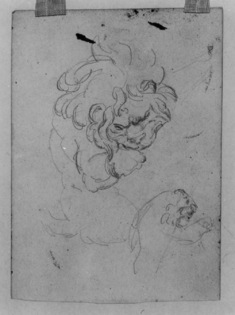Milo of Croton Devoured by a Lion
(18th and 19th Centuries )
Milo was an athlete in 6th-century BC Croton (present-day Crotone, Italy). Late in life, he attempted to demonstrate his strength by pulling apart a split tree trunk. The tree closed on his hand, holding him captive while wild animals devoured him. This ancient myth is a parable on excessive pride. As a student at the École des Beaux-Arts, the leading French art school, Barye placed second when he entered this composition in a contest for the grand prize in medals.
For the plaster version of this medal see WAM 27.191.
Inscription
Provenance
Provenance (from the French provenir, 'to come from/forth') is the chronology of the ownership, custody, or location of a historical object. Learn more about provenance at the Walters.
William T. / Henry Walters Collection, Baltimore [date and mode of acquisition unknown] [from 5 West Mt. Vernon Place]; Walters Art Museum, 1931, by bequest.
Exhibitions
| 2007-2008 | Untamed: The Art of Antoine-Louis Barye. The Walters Art Museum, Baltimore; Philbrook Museum of Art, Tulsa; The Henry Morrison Flagler Museum, Palm Beach. |
| 1980-1981 | The Romantics to Rodin: French Nineteenth Century Sculpture from North American Collections. Los Angeles County Museum of Art, Los Angeles; Minneapolis Institute of Art, Minneapolis; The Detroit Institute of Arts, Detroit; Indianapolis Museum of Art, Indianapolis. |
Geographies
France, Paris (Place of Origin)
Measurements
H: 2 13/16 x W: 2 13/16 x D: 2 13/16 in. (7.1 x 7.1 x 7.1 cm)
Credit Line
Acquired by William T. or Henry Walters
Location in Museum
Not on view
Accession Number
In libraries, galleries, museums, and archives, an accession number is a unique identifier assigned to each object in the collection.
In libraries, galleries, museums, and archives, an accession number is a unique identifier assigned to each object in the collection.
27.507




